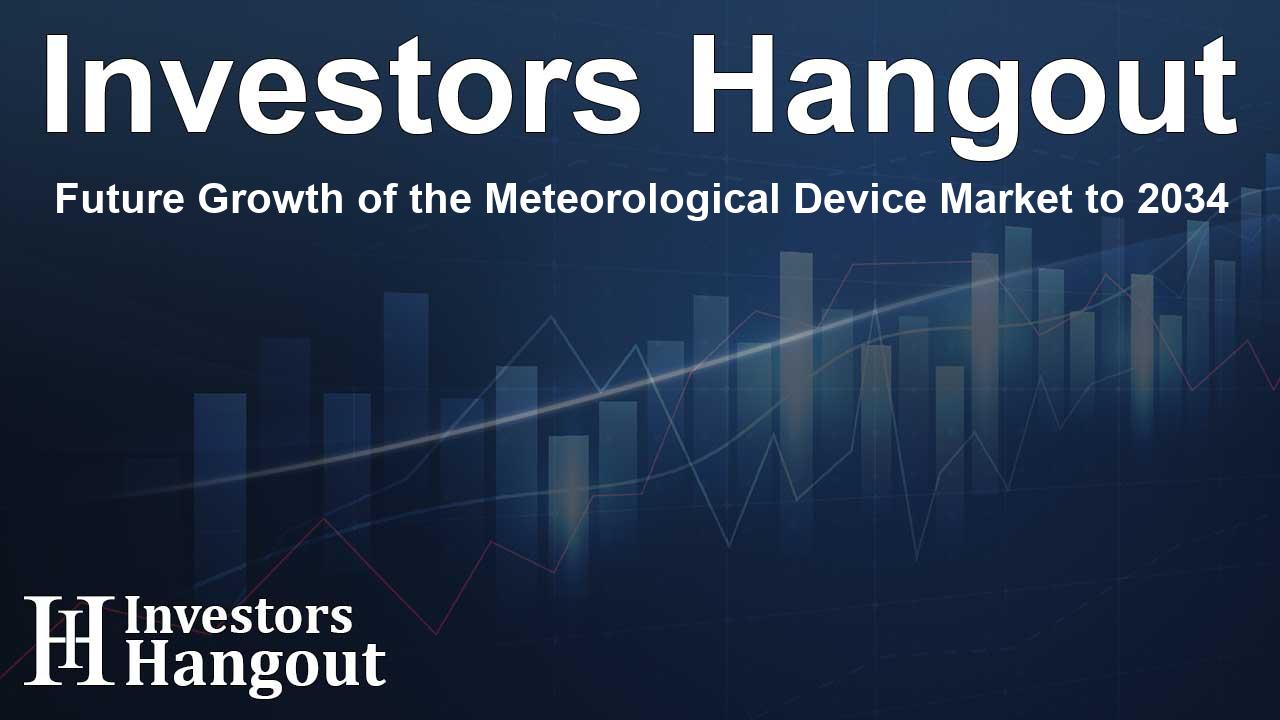Future Growth of the Meteorological Device Market to 2034

Introduction to the Meteorological Device Market
The meteorological device market is currently thriving, having achieved a substantial valuation and set to expand significantly. This industry is witnessing robust growth, fueled by emerging climate challenges and the pressing demand for precise weather forecasting technologies. As climate changes become increasingly erratic, industries across the board recognize the importance of reliable weather data.
Market Drivers Influencing Growth
The global meteorological device market, now valued at approximately USD 6.8 billion, is projected to soar to USD 11.5 billion by 2034, which represents a Compound Annual Growth Rate (CAGR) of 5.4%. This growth is largely propelled by several factors, including:
- Increasing Climate Volatility: The rise in extreme weather events has prompted both governments and businesses to invest in advanced weather monitoring solutions to enhance preparedness and response strategies.
- Technological Advancements: The integration of technologies such as the Internet of Things (IoT) and Artificial Intelligence (AI) into meteorological equipment is transforming data collection and analysis, enhancing predictive accuracy.
- Growing Awareness: There is an increasing consciousness regarding climate change among the public and businesses alike, further amplifying the need for real-time weather data.
- Smart City Developments: Urban areas are looking to invest more in technology-driven environmental monitoring for better city planning and safety enhancement.
- Agricultural Innovation: The agricultural sector is heavily reliant on accurate weather data, utilizing it for efficient yield planning and resource management.
Technological Innovations Shaping the Future
Technological innovation stands out as a pivotal aspect driving market expansion. The advent of IoT devices allows for seamless transmission of weather data from various sensors stationed in remote locations, enabling enhanced forecasting models. Furthermore, AI technology is empowering forecasting tools to draw from vast data sets, thereby honing accuracy in predictions.
Another burgeoning trend is the proliferation of cloud-based forecasting platforms. These platforms are tailored for user accessibility, breaking down barriers for smaller enterprises and individual users who may lack extensive technical expertise. This democratization of data enables a wider segment of users, including small-scale farmers, to benefit from high-quality meteorological insights.
Market Segmentation Overview
The meteorological device market may be divided into several product categories, each contributing uniquely to the industry's growth:
Sensors
Sensors including humidity, temperature, pressure, and wind speed dominate the market by representing roughly 40% of total revenues. These devices are integral across various sectors, including agriculture, environmental monitoring, and even disaster management.
Weather Stations
Weather stations, which include both personal and professional use, are increasingly popular. Personal weather stations have seen adoption within home automation spheres, while professional-grade versions remain crucial for commercial and governmental applications.
Data Loggers
Comprising around 15% of the market, data loggers are increasingly bundled with wireless capabilities, providing real-time data logging functionalities.
Weather Radars and Forecasting Software
Next-generation weather radars, including Doppler systems, are critical for tracking storm patterns. Additionally, forecasting software that leverages AI continues to evolve, capturing about 8% market share.
Regional Insights and Market Share
Currently, North America leads the meteorological device market, accounting for approximately 40% of global revenues. This dominance is attributed to substantial government investments, flourishing R&D initiatives, and high adoption in sectors like aviation and agriculture.
Europe follows closely with about 30% market share, bolstered by stringent environmental regulations and increased investment in meteorological technologies. The Asia-Pacific region is quickly emerging as the fastest-growing market, anticipated to report an impressive CAGR of 8%, driven by rapid urbanization and government initiatives aimed at climate resilience.
Challenges and Future Opportunities
While the growth trajectory of the meteorological device market looks promising, several challenges exist. High initial investment costs, supply chain disruptions, and regulatory complexities can impede market expansion. However, growth avenues remain abundant, particularly in sectors like renewable energy and personalized weather services.
Notably, the demand for subscription-based weather data services is on the rise, indicating a shift towards more scalable and user-friendly models. Satellite-based meteorological solutions are also experiencing increased investment, catering to the needs of various stakeholders seeking real-time data engaged in climate-sensitive operations.
Competitive Landscape and Recent Developments
The competitive landscape within the meteorological device market is heating up, with key players like Vaisala, Campbell Scientific, and Kestrel Meters introducing innovative products and partnerships. For instance, Vaisala recently launched its cutting-edge Vaisala Weather Transmitter WXT536, which offers comprehensive sensor capabilities in a compact design, pushing the standards for accuracy and real-time data collection.
Frequently Asked Questions
What is the current valuation of the meteorological device market?
The meteorological device market is currently valued at approximately USD 6.8 billion.
When is the market projected to reach USD 11.5 billion?
The market is projected to reach USD 11.5 billion by 2034.
What are the main drivers for market growth?
Key drivers include increasing climate volatility, technological advancements in measurement tools, and growing awareness about climate change.
Which region leads in the meteorological device market?
North America leads the market, contributing around 40% of total revenues.
What are the recent trends in meteorological technology?
Recent trends include the integration of IoT and AI into meteorological tools, leading to improved data accuracy and accessibility for users.
About The Author
Contact Addison Perry privately here. Or send an email with ATTN: Addison Perry as the subject to contact@investorshangout.com.
About Investors Hangout
Investors Hangout is a leading online stock forum for financial discussion and learning, offering a wide range of free tools and resources. It draws in traders of all levels, who exchange market knowledge, investigate trading tactics, and keep an eye on industry developments in real time. Featuring financial articles, stock message boards, quotes, charts, company profiles, and live news updates. Through cooperative learning and a wealth of informational resources, it helps users from novices creating their first portfolios to experts honing their techniques. Join Investors Hangout today: https://investorshangout.com/
The content of this article is based on factual, publicly available information and does not represent legal, financial, or investment advice. Investors Hangout does not offer financial advice, and the author is not a licensed financial advisor. Consult a qualified advisor before making any financial or investment decisions based on this article. This article should not be considered advice to purchase, sell, or hold any securities or other investments. If any of the material provided here is inaccurate, please contact us for corrections.
